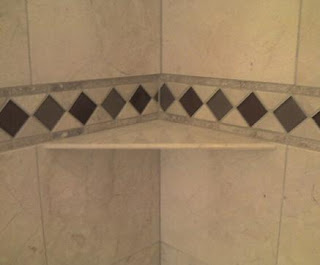since we are a Ceramic, Quarry, Saltillo, Porcelain & Travertine
Tile Contractor in Florida these questions come up to us a lot
from Homeowners, Builders, Architects & Customers.
I hope this will explain to you some of the differences.
Grout:
Grout for ceramic tile is a cement-based bonding material used for filling joints between tiles. The space left between tiles to be filled is called a grout joint. The grout joint between the tiles is usually very porous, therefore, it needs to be sealed and maintained properly to prevent stains and discoloration. Protected tile and grout for ceramic tile will be easier to clean, more resistant staining, and provide a safer and healthier environment.
Types of grout for ceramic tile:There are four basic types of grout for ceramic tile: Unsanded, fine sanded, quarry type and epoxy.
* Unsanded grout for ceramic tile: This is used for wall tiles where the grout joint is less than 1/8" wide.
* Finely Sanded grout for ceramic tile: This is used for floor tiles where the joints are 1/8" to 3/8" wide.
* Quarry-type grout for ceramic tile: This is the same as finely sanded grout for ceramic tiles except that a coarser grade of sand is used. The quarry-type grout for ceramic tile is used for joints that are 3/8" wide to 1/2" wide such as those used with Saltillo tiles.
* Epoxy grout for ceramic tile: This consists of an epoxy resin and hardener. Epoxy grout for ceramic tile is highly resistant to stains and chemicals and has a tremendous bonding strength. It is ideal for countertops and other areas susceptible to stains.
Some important considerations when choosing grout for ceramic tile:* The wider the joint, the coarser the sand has to be. The sand prevents the grout for ceramic tile from shrinking and cracking.
* Grout for ceramic tiles comes in a wide variety of pre-mixed colors.
* The standard size of wall joint is 1/16" wide.
* The standard size of grout joint for floor tiles is 1/4" wide (finely sanded).
* Because floor tiles may vary slightly in size, grout joints in the floor tiles should not be smaller than 3/16". The installer will not be able to keep a straight line if the joint is too narrow.
* Impregnating sealers go into the grout joint and protect against water and oil-based stains.
* To prevent or limit staining problems in grout for ceramic tile, latex additives or a sealer is recommended. The latex additive forms a rubber-like film over the pores in the grout for ceramic tile, thus limiting its tendency to absorb stains. However, it is not completely stain proof.
Sealers:A sealer is a liquid coat applied to the porous surface of the tile or grout, to protect them from oxidation, natural deterioration and day-to-day wear. Typically speaking, sealers are used to protect unglazed tiles and grouts from absorbing stains. Take a look at these guidelines, which are meant to get you started when it comes to choosing the right sealant for your ceramic or porcelain tile project:
Types:There are two types of major types of sealers for ceramic tile or porcelain tile:* Penetrating Sealers: These are absorbed into the tile or grout, forming a stain resistant shield just below the surface. Most penetrating sealers will not change the appearance of the tile.
* Surface Sealers: These are coated on the top of tile and grout, forming a non-porous, stain resistant sealant. The surface sealer will enhance the rich natural colors of the tile and adds a slight luster as well.
Important Considerations:* The surface of most ceramic and porcelain tiles does not need to be sealed, although some require a light application of a penetrating sealer to fill the micro pores on the surface of the tile.
* However, all unglazed tiles including dense porcelains, should be sealed prior to grouting. It will prevent the grout from staining the tile, especially when a dark colored grout is being used with a light colored tile.
* Impregnating sealers go into the grout joint and protect against water and oil-based stains.
* Highly absorbent tiles such as hand made Saltillo tiles must be permanently sealed with either a penetrating or surface sealer.
* Use only penetrating sealers on dense, unglazed tiles such as quarries or porcelains.
* It is important to follow your distributor's recommendations as well as reading the instructions on the product being used.
It's a good idea to ask the experts about which type of sealer performs best for the type of tile you have for further details. If color change is a concern, or staining resistance, then these are the questions to put to your seller. Talk to your ceramic or porcelain sales rep, or your local retailer about the latest products for sealing ceramic tile, porcelain tile, quarry tile, saltillo tile or travertine tile. Ask about whether penetrating sealers vs. surface sealers with regard to your specific tile and aesthetic expectations & find out which is the best fit for your project.



















































